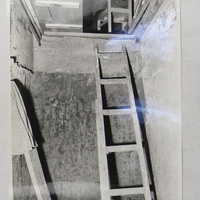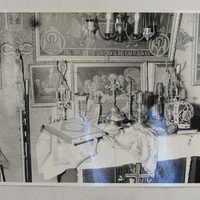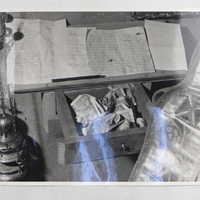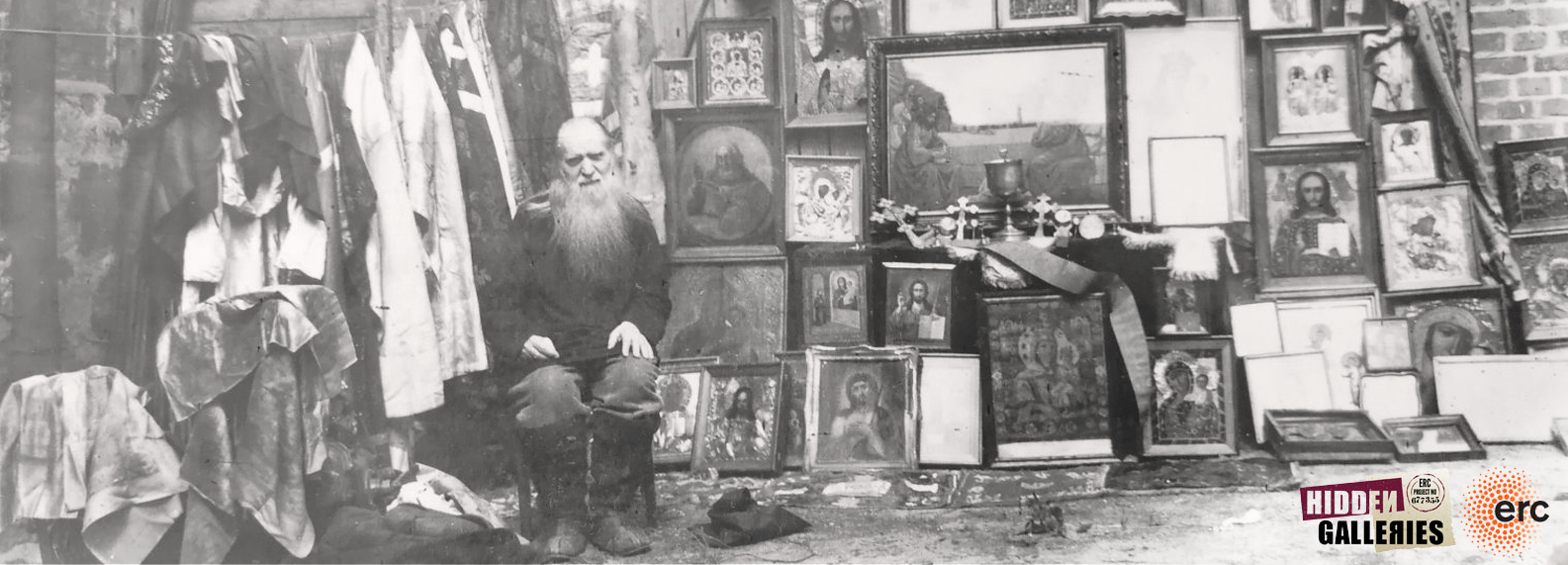Images of Old Calendarist underground church in Bucharest
Item
Title
Images of Old Calendarist underground church in Bucharest
Imagini ale unei biserici ortodoxe de stil vechi clandestine în București
Description
The 4 images are taken from a secret police personal file and were used as evidence of an Old Calendarist underground monastery in Bucharest. The community was led by the Old Calendarist bishop Evloghie Oța. According to the communist state legal framework, the Old Calendarist Orthodox Church was an illegal entity. These pictures documented a sweep operation of the secret police that ended in the destruction of the underground church and the arrest of the bishop.
We cannot date the pictures precisely because the community kept rebuilding the underground chapel and the secret police destroyed it each time from 1965 until 1983. The community dated from 1964 when their bishop was released from prison and was held together under his charismatic leadership. During the 26 years of the community existence under communism their number increased gradually. They had several brothers in the monastery and a parish that consisted of regular church goers and people that came from time to time from various places across Romania. The bishop visited and maintained a correspondence with the geographically distant members of his flock. This form of parish is typical for an Old Calendarist community in the communist period but not typical for a regular Romanian Orthodox Church parish. For this reason the numbers of believers cannot be accurately assessed.
The file contains several other pictures (14 in total) and two maps of the house and the underground chapel. The pictures follow standard crime scene photographic principles, illustrating the exterior, means of entry to the underground chapel as well as the main incriminating evidence and close up details of particular elements that elucidate the crime. They also show the methods by which the building was transformed from a house into an illegal underground chapel including photos linking the bishop and parishioners to the site.
The pictures selected here, illustrate common tropes of illegal religious activity: the route of entry via a ladder to the underground chapel; the ritual space; and the means by which the community financed itself.
The third picture reveals the altar table and icons surrounding it together with religious service books, candles and items of from episcopal paraphernalia. Note particularly the crosier and the mitre, both elements that indicate the rank of the officiant that is not present in the picture.
The forth picture in this entry shows the money next to several diptychs (several lists of names for whom religious service has to be held are observable in the picture). A stole and a censer can also be seen in this picture, religious objects and garments effectively linking the money to the religious service provided.
Although the secret police implied that the community was hiding underground the Old Calendarist subterranean religious spaces and/ or underground chapels were not necessarily used for hiding in. There is an Orthodox Christian monastic tradition of locating sites of worship in cave and subterranean spaces.
For related entries see:
We cannot date the pictures precisely because the community kept rebuilding the underground chapel and the secret police destroyed it each time from 1965 until 1983. The community dated from 1964 when their bishop was released from prison and was held together under his charismatic leadership. During the 26 years of the community existence under communism their number increased gradually. They had several brothers in the monastery and a parish that consisted of regular church goers and people that came from time to time from various places across Romania. The bishop visited and maintained a correspondence with the geographically distant members of his flock. This form of parish is typical for an Old Calendarist community in the communist period but not typical for a regular Romanian Orthodox Church parish. For this reason the numbers of believers cannot be accurately assessed.
The file contains several other pictures (14 in total) and two maps of the house and the underground chapel. The pictures follow standard crime scene photographic principles, illustrating the exterior, means of entry to the underground chapel as well as the main incriminating evidence and close up details of particular elements that elucidate the crime. They also show the methods by which the building was transformed from a house into an illegal underground chapel including photos linking the bishop and parishioners to the site.
The pictures selected here, illustrate common tropes of illegal religious activity: the route of entry via a ladder to the underground chapel; the ritual space; and the means by which the community financed itself.
The third picture reveals the altar table and icons surrounding it together with religious service books, candles and items of from episcopal paraphernalia. Note particularly the crosier and the mitre, both elements that indicate the rank of the officiant that is not present in the picture.
The forth picture in this entry shows the money next to several diptychs (several lists of names for whom religious service has to be held are observable in the picture). A stole and a censer can also be seen in this picture, religious objects and garments effectively linking the money to the religious service provided.
Although the secret police implied that the community was hiding underground the Old Calendarist subterranean religious spaces and/ or underground chapels were not necessarily used for hiding in. There is an Orthodox Christian monastic tradition of locating sites of worship in cave and subterranean spaces.
For related entries see:
Cele 4 fotografii sunt preluate dintr-un dosar individual al poliției secrete și au fost folosite ca dovezi ale existenței unei mănăstiri ortodoxe de stil vechi clandestine din București. Comunitatea era condusă de episcopul ortodox de stil vechi Evloghie Oța. Conform cadrului legal al statului comunist, Biserica Ortodoxă Română de stil vechi era o entitate ilegală. Aceste imagini au documentat o operațiune complexă a poliției secrete care s-a încheiat cu distrugerea bisericii clandestine și arestarea episcopului.
Nu putem să datăm cu exactitate imaginile tocmai pentru că comunitatea a continuat să reconstruiască biserica clandestină și poliția secretă a distrus-o de fiecare dată din anul 1965 până în anul 1983. Comunitatea ortodoxă de stil vechi din București datează din anul 1964, când episcopul lor a fost eliberat din închisoare și a construit această comunitate conducerea sa carismatică. În cei 26 de ani de existență a comunității sub comunism numărul acesteia a crescut treptat. Aveau mai mulți frați de mănăstire și o parohie care era formată din enoriași obișnuiți ai bisericii și oameni care veneau din când în când din diferite locuri din România. Episcopul a vizitat și a menținut o corespondență cu membrii mai îndepărtați geografic ai turmei sale. Această formă de parohie este tipică pentru o comunitate ortodoxă de stil vechi din perioada comunistă, dar nu este tipică pentru o parohie obișnuită a Bisericii Ortodoxe Române. Din acest motiv, numărul credincioșilor nu poate fi evaluat cu exactitate.
Dosarul conține alte câteva imagini (14 în total) și două hărți ale casei și ale bisericii clandestine. Imaginile respectă principiile fotografice standard ale scenei crimei, ilustrând exteriorul, intrarea principală în biserica clandestină, precum și principalele dovezi incriminatoare și detalii amănunțite ale unor elemente particulare care elucidează ilegalitățile. Acestea arată, de asemenea, metodele prin care clădirea a fost transformată dintr-o casă într-o biserică ilegală, inclusiv fotografii care fac legătura între episcop, enoriași și locul respectiv.
Imaginile selectate aici ilustrează tropii comuni ai activității religioase conspirative: calea de intrare printr-o scară către biserica clandestină; spațiul ritual; mijloacele prin care comunitatea s-a autofinanțat.
A treia imagine dezvăluie masa altarului și icoanele care o înconjoară, împreună cu cărți pentru slujba religioasă, lumânări și obiecte de îmbrăcăminte episcopală. Rețineți în special cârja episcopală și mitra, ambele elemente care indică rangul oficiantului care nu este prezent în imagine.
A patra imagine prezintă banii alături de mai multe diptice (mai multe liste de nume pentru care trebuie să se țină slujba religioasă sunt observabile în imagine). În această imagine mai pot fi văzute o stolă și o cădelniță, obiecte religioase și îmbrăcăminte care leagă efectiv banii de serviciul religios oferit.
Deși poliția secretă a sugerat prin succesiunea imaginilor că această comunitate se ascundea sub pământ, spațiile religioase ortodoxe de stil vechi sub pământ și / sau bisericile clandestine nu erau neapărat folosite pentru a se ascunde. Există o tradiție monahală creștină ortodoxă de localizare a locurilor de cult în peșteri și spații subterane.
Pentru rubrici similare, vezi:
Subject
Communism and Religion
Material Culture--Religious aspects
Religious groups
Communism--Romania
Evidence photographs
Evidence fabrication
Secret Police
Creator
Anca Șincan
Source
Consiliul Național pentru Studierea Arhivelor Securității (CNSAS)
I161963, vol 1
I161963, vol 1
Publisher
This project has received funding from the European Research Council (ERC) under the European Union’s Horizon 2020 research and innovation programme No . 677355
Date
1965-1979
Rights
Copyright for these images belongs to Consiliul Național pentru Studierea Arhivelor Securității - CNSAS
Format
image/ jpeg
Photo
Language
RO
Type
image
Identifier
CNSAS
I161963, vol 1
I161963, vol 1
Coverage
20th century
Romania
Romania
Bibliographic Citation
Anca Sincan, "Images of Old Calendarist underground church in Bucharest"
Date Created
2018
Item sets
 Entry to the underground chapel
Entry to the underground chapel  Believers at Religious Service
Believers at Religious Service  Altar table of underground church
Altar table of underground church  Financial means to support the church
Financial means to support the church 